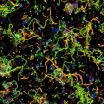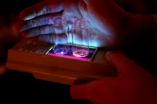(Press-News.org) ANN ARBOR, Mich.---Scientists have discovered a molecular assistant called Spy that helps bacteria excel at producing proteins for medical and industrial purposes.
Bacteria are widely used to manufacture proteins used in medicine and industry, but the bugs often bungle the job. Many proteins fall apart and get cut up inside the bacteria before they can be harvested. Others collapse into useless tangles instead of folding properly, as they must in order to function normally.
A research team led by James Bardwell, who is a professor of molecular, cellular and developmental biology and of biological chemistry, as well as a Howard Hughes Medical Institute investigator, at the University of Michigan, developed a way to coerce bacteria into making large quantities of stable, functional proteins. Then, in exploring why these designer bacteria were so successful, the scientists discovered the molecular helper, Spy.
The research is scheduled for online publication Feb.13 in the journal Nature Structural & Molecular Biology.
In the first phase of the research, the team designed biosensors that directly link protein stability to the antibiotic resistance of bacteria. When a poorly folded, unstable protein is inserted into the middle of the biosensor in a bacterium, it disrupts the bug's resistance to antibiotics. When the protein is stabilized, resistance is restored.
The researchers inserted a particularly unstable protein into Escherichia coli (E. coli), which forced the bacteria to either adapt by improving protein stability or die when exposed to antibiotics. Through a "directed evolution" experiment, in which the scientists selected colonies with increasing antibiotic resistance---and increasing protein stability—the team generated designer bacteria that produced up to 700 times more of the previously unstable protein.
"It is exciting to realize that if even bacteria are asked in the right way, they can come up with good solutions to hard problems," said postdoctoral fellow Shu Quan, who spearheaded the work.
In looking to see why the designer bacteria were so much better at producing proteins, the scientists found that the efficient microbes were making much more of a small protein called Spy. Further study showed that the cradle-shaped Spy aids in protein refolding and protects unstable proteins from being cut up or sticking to other proteins.
"Our work may usher in an era of designer bacteria that have had their folding environment customized so that they can now efficiently fold normally unstable proteins," Bardwell said.
INFORMATION:
The work was conducted in Bardwell's lab at U-M. Mirek Cygler's laboratory at McGill University solved the structure of the Spy protein. In addition to Bardwell, Quan and Cygler, the paper's authors are masters students Philipp Koldewey and Stephan Hofmann; undergraduate students Nadine Kirsch and Jennifer Pfizenmaier; postdoctoral research associates Tim Tapley, Linda Foit and Guoping Ren; associate professor Ursula Jakob and associate professor Zhaohui Xu; all of U-M; and Karen Ruane and Rong Shi of McGill University.
The researchers received funding from Howard Hughes Medical Institute and the Canadian Institutes of Health Research.
For more information:
James Bardwell: http://www.ns.umich.edu/htdocs/public/experts/ExpDisplay.php?beginswith=Bardwell
Nature Molecular and Structural Biology: http://www.cell.com/molecular-cell/home
Quest for designer bacteria uncovers a 'Spy'
2011-02-15
ELSE PRESS RELEASES FROM THIS DATE:
New scholarly paper reveals 100 new species of lichenized fungi
2011-02-15
CHICAGO, IL – In an unprecedented coming-out party, 100 newly discovered species are revealed to the world in a single scholarly paper coordinated by Field Museum scientists.
The 100 organisms are lichens, a type of fungi that form associations with algae and populate environments from arctic tundra to tropical rain forests. And the usual inattention bestowed upon new lichens is one reason for aggregating so many new ones in a single paper in the Feb. 18 issue of the journal Phytotaxa.
It is estimated that about 100,000 fungal species, including 17,500 lichens, have been ...
Choosing your neighbors: MBL scientists see how microbes relate in space
2011-02-15
MBL, WOODS HOLE, MA—Like people in cities, microbes often live in complex communities that contain many different microbial types. Also like us, microbes tend to gravitate to and "hang out" with certain other types in their community, more than with the rest. And sometimes, when opportunities arise, they move to more favorable locations.
But until recently, scientists have not been able to look at a microbial community and distinguish the spatial relationship of more than 2 or 3 kinds of microbes at once.
Now, a microscopy technique developed at the Marine Biological ...
Jewel-toned organic phosphorescent crystals: A new class of light-emitting material
2011-02-15
ANN ARBOR, Mich.---Pure organic compounds that glow in jewel tones could potentially lead to cheaper, more efficient and flexible display screens, among other applications.
University of Michigan researcher Jinsang Kim and his colleagues have developed a new class of material that shines with phosphorescence---a property that has previously been seen only in non-organic compounds or organometallics.
Kim and his colleagues made metal-free organic crystals that are white in visible light and radiate blue, green, yellow and orange when triggered by ultraviolet light. ...
Treating the aging knee as an organ
2011-02-15
DETROIT – The human body is made up of several organs composed of tissues that enable them to perform a particular function. The heart circulates blood; the brain is the micro-neuro center of the body; the lungs bring in oxygen and release carbon dioxide.
The failure of any one of these tissue systems can cause serious health issues, even death. When components of the organ are fixed, typically the organ functions better. For instance, unclogging a blocked artery with a balloon stent improves blood circulation to and from the heart.
Henry Ford Hospital researcher Fred ...
Does social anxiety disorder respond to psychotherapy? Brain study says yes
2011-02-15
When psychotherapy is helping someone get better, what does that change look like in the brain? This was the question a team of Canadian psychological scientists set out to investigate in patients suffering from social anxiety disorder. Their findings are published in Psychological Science, a journal of the Association of Psychological Science.
Social anxiety is a common disorder, marked by overwhelming fears of interacting with others and expectations of being harshly judged. Medication and psychotherapy both help people with the disorder. But research on the neurological ...
UCLA Engineering advance with new nanomaterials good news for next-generation electronic devices
2011-02-15
In recent years, topological insulators have become one of the hottest topics in physics. These new materials act as both insulators and conductors, with their interior preventing the flow of electrical currents while their edges or surfaces allow the movement of a charge.
Perhaps most importantly, the surfaces of topological insulators enable the transport of spin-polarized electrons while preventing the "scattering" typically associated with power consumption, in which electrons deviate from their trajectory, resulting in dissipation.
Because of such characteristics, ...
Physicists isolate bound states in graphene-superconductor junctions
2011-02-15
CHAMPAIGN, Ill. — Illinois researchers have documented the first observations of some unusual physics when two prominent electric materials are connected: superconductors and graphene.
Led by University of Illinois physics professor Nadya Mason, the group published its findings in the journal Nature Physics.
When a current is applied to a normal conductor, such as metal or graphene, it flows through the material as a stream of single electrons. By contrast, electrons travel in pairs in superconductors. Yet when a normal material is sandwiched between superconductors, ...
Psychology students to present on cheaper textbook alternatives at national conference
2011-02-15
A group of University of Cincinnati seniors in the psychology program will nationally present their comparison of educational technology alternatives to purchasing college textbooks that can run into hundreds of dollars per academic quarter. Their research as part of the statewide Ohio Digital Bookshelf Project will be presented on Monday, Feb. 14, at the national EDUCAUSE Annual Meeting in Washington, DC.
The Digital Bookshelf Project is an initiative under the University System of Ohio (USO) Strategic Plan for Higher Education to develop a high-quality, affordable, ...
Gene that regulates immune system linked to preeclampsia
2011-02-15
Researchers at North Carolina State University have discovered that the placentas of women who suffer preeclampsia during pregnancy have an overabundance of a gene associated with the regulation of the body's immune system. Their discovery may lead to improved screening and prenatal care for these patients and their babies.
Preeclampsia occurs in up to 10 percent of all pregnancies, and is responsible for about 15 percent of pre-term births. The disorder is usually marked by a rapid rise in blood pressure that can lead to stroke, seizures or organ failures in the mother. ...
Study shows year-end test scores significantly improved in schools using Web-based tutor
2011-02-15
WORCESTER, Mass. – Year-end test scores of Massachusetts middle school students whose teachers used a Web-based tutoring platform called ASSISTments as a central part of their mathematics instruction were significantly better than those of students whose teachers did not use the platform, according to a recent study published in the Journal of Educational Computing Research. Conducted by Neil T. Heffernan, PhD, of Worcester Polytechnic Institute (WPI), and Kenneth R. Koedinger, PhD, and Elizabeth A. McLaughlin, both of Carnegie Mellon University, the study examined data ...



